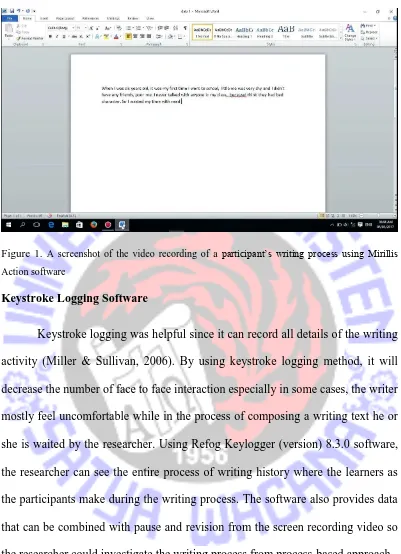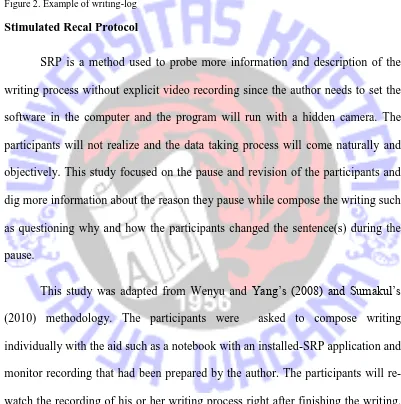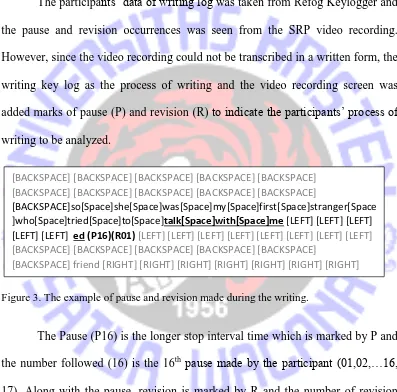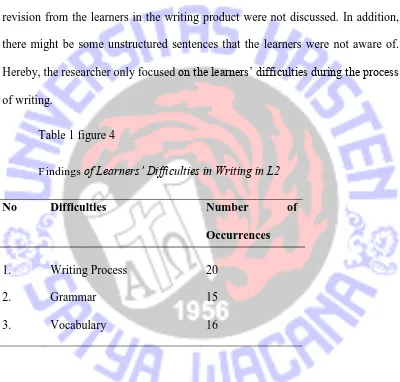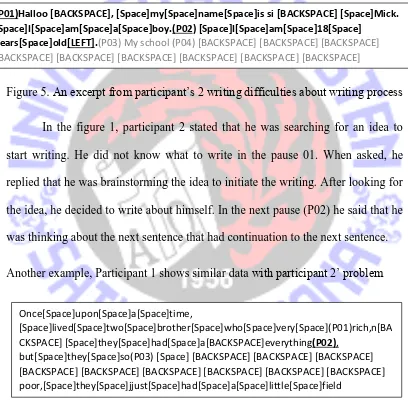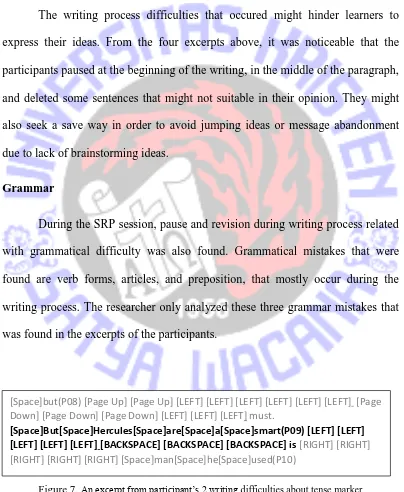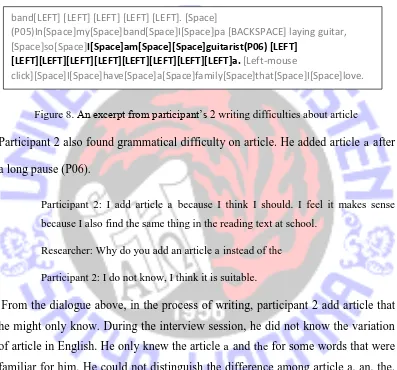i
INVESTIGATING ENGLISH LANGUAGE LARNERS’
DIFFICULTIES WHILE COMPOSING WRITING IN L2
A THESIS
Submitted in Partial Fullfilment
of the Requirements for the Degree of
Sarjana Pendidikan
Febryana Sukma Ramadhani
112013069
ENGLISH LANGUAGE EDUCATION
FACULTY OF LANGUAGE AND ARTS
UNIVERSITAS KRISTEN SATYA WACANA
SALATIGA
v
COPYRIGHT STATEMENT
This thesis contains no such material as has been submitted for examination in any course or accepted for the fulfillment of any degree or diploma in any university. To the best of my knowledge and my belief, this no material previously published or written by any other person except were due reference is made in the text.
Copyright@2017. Febryana Sukma Ramadhani and Dian Toar Y. G. Sumakul, M.A.
vii
I. L2 Writing and Cognitive Process ... 3
II. Pauses and Revisions ………...…………..……….... 4
III. Process-based Approach ………5
The Study ... 7
A. Context of the Study ... 7
B. Participants ... 7
C. Instrument of Data Collection ... 8
1
ABSTRACT
Since English has become one of important skill in this era of Globalization, education setting in all countries introduces English as one of course provided for learners. To investigate the needs and obstacles that learners may find during the learning, this research is attempted to answer the question of the difficulties that learners find during the writing process. By referring to Kelogg (1994) and Matsuhashi (1987) theory of cognitive process and pause revision, this study explored learners’ difficulties during the process of writing in English learning (L2). Using SRP as the data collection tools, five learners from one of Senior High Schools in Salatiga were selected as the participants. The findings show that the learners experienced difficulties in writing process, grammatical and vocabularies during the process of writing. The study posed these problem faced by learners to teachers in order to decrease learners inability in using the skills particularly writing skill properly.
Keywords: SRP, pause and revision, writing process, grammar, vocabulary
INTRODUCTION
Writing is an important skill in educational setting, especially in English learning (L2) in Indonesia context. Even though L2 writing is very common in L2 classroom, it is unavoidable that writing in L2 is still challenging for students. Students may find difficulties in L2 writing process, especially because they have to write using another language. The difficulty lies on the notion that writing is ongoing process and learners suffer from what so-called as L1 interference while writing in their L2.
2
grammar rule, lack of vocabularies, text organization, correct citation and reference are common difficulties that L2 students have in L2 writing. Lack of vocabulary knowledge is also an obstacle since students cannot develop a critical argument; instead they are only able to write simple sentences only. In order to overcome this problem, students may have some strategies to use during their writing to overcome the difficulties. Strategies that may be used are in line with the argument of Flower & Hayes (1981) that writing is seen as a process, not a product base.
3
LITERATURE REVIEW
L2 Writing and Cognitive process
In second language writing (L2 Writing), the writer always deals with negotiation of meaning (Foster, 2005). The brain will recall the innate while the writer starts composing the writing. It is also interesting that first language of the writer will give either positive or negative transfer towards the L2 writing process. Writing is a process that involves cooperation of the brain and knowledge. Writing goes with choosing dictation, syntactic pattern, organizational pattern, content, and purpose (Odell et. al. as cited in Flower & Hayes, 1981). The process might follow a selection of the lexical, semantical, or topical aspect in order to compose a noticeable writing.Flower & Hayes (1981) notes that the writing phase is also divided into some parts, to answer basic questions what, where, how or use writing strategies such as the accurateness of coherency in text, do pre-writing and free writing. They also argue that pre writing, writing, and revising are the major process during the writing stage.
4
Apparently, Flower & Hayes (1981) believe that writing is part of a long cognitive process that needs extra struggle to accomplish and art that combine lexis and content into a coherent unit. The judgment whether a good writing is about the syntactic aspects or the semantics part depends on the context. Cognitively, different background knowledge may give a big contribution to the writing which incorporates with the content of the text. Language awareness of the writers may affect the smoothness sense of each paragraph as well. Hence, it could be different point of view in judging which writing is seen as a nutshell.
In addition, in the writing process, one main problem that learners encounter as one of difficulty aspects is language. It is a process where a person transfers L1 knowledge to L2 (Richards et al. (1992); Dulay et al. (1982); Ellis (1997:51 as cited in Brown, 1987). L1 interference may influence and cause the negative transfer to the process of making and producing discourse or text. Merely transfer L1 to L2 will lead to negative transfer and it influences the quality of texts such as acceptable meaning, neutrality, and appropriate linguistic structure (Hussein and Mohammad, 2012). L1 interference happens because there is difference between L1 and L2. Negative transfer occurs when a learner transfers L1 structures that is not exist in L2 (Hussein and Mohammad, 2012). Learners use the ability to transfer L1 structure that mostly different and do not found in L2 structure. Hence, the transfer of language can interfere the process of writing particularly for writing in L2.
Pauses and Revisions
5
and not only transcribed” (Susser, 1994 p. 35). Most students do not realize in the
process of writing, they often use strategy. Hence, in the writing composition, focus on the process has been highlighted as the major source for research (Miller & Sullivan, 2006). The process of writing may involve some performance in mind that affect the behavior of the writers. According to Kellogg (1994), the performance of writing can be seen by the result of writing, direct assessing, writing fluency, and time allocation. One way to measure writing performance is process-based approach that mainly focuses on pauses and revisions. Matsuhashi as cited in Kellogg, 1994), finds that most of writers use pause during writing process. From the previous researches, it can be drawn a conclusion that writers mostly pause during the writing. The time duration may be various, depending on the proficiency of the writers or the selected topics. Pauses in writing also be categorized as strategy since writers introspect their writing during the pause (Kellogg, 1994).
During the pause, students often revise their writing. Revision can be one good way to discover mistakes such as grammar error, illogical sentence, citation, and ambiguity (Hayes, Flower, Schriver, Statman, & Carey, 1987 as cited in Lindgren & Sullivan, 2002). Revision occurs when students revise to improve their writing into a well-organized pattern. Students need to be aware of the mistakes and use the appropriate plan to improve their writing according to the detected mistakes (Lindgren & Sullivan, 2002).
Process-based Approach
6
7
THE STUDY
Context of the Study
This study is a qualitative study in which the initial assumption is analyzed in general as a complete part and involved small number of participants (Zakarias, 2013). The qualitative study probed more information, describe the condition, and present the data in words. This study took place in Salatiga with selected public Senior High School where English has been a compulsory subject especially for Senior High School students. The English course approximately runs for five hours in a week.
Participants
The total number consisted of five participants; all of them were in the same institution grade 11.They approximately had been learning English since Elementary School. The participants also learned four language skill such as writing, speaking, listening, and reading. Therefore with their past experiences and background knowledge of English, it was possible to investigate their ability in using the L2 skills particularly writing skill.
Instrument of Data Collection
Screen Recording Software
8
Figure 1. A screenshot of the video recording of a participant’s writing process using Mirillis Action software
Keystroke Logging Software
9
Figure 2. Example of writing-log
Stimulated Recal Protocol
SRP is a method used to probe more information and description of the writing process without explicit video recording since the author needs to set the software in the computer and the program will run with a hidden camera. The participants will not realize and the data taking process will come naturally and objectively. This study focused on the pause and revision of the participants and dig more information about the reason they pause while compose the writing such as questioning why and how the participants changed the sentence(s) during the pause.
10
participants since they were learning particular topic such as narrative, recount, and procedure text genres. The participants freed to decide the topic that they were comfortable with, so the obstacles in the writing process could prevent the participants from writing without adequate background information from particular topics. During the writing process, the participants were allowed to look up the dictionary so they were not burdened in the writing process.
Data Analysis
11
Findings and Discussion
In this section, the data analysis is presented. The data was analyzed using methodology adapted from Sumakul (2010). Due to the efficiencies of the discussion, only some transcripts were presented as the examples of the analysis.
The participants’ data of writing log was taken from Refog Keylogger and the pause and revision occurrences was seen from the SRP video recording. However, since the video recording could not be transcribed in a written form, the writing key log as the process of writing and the video recording screen was added marks of pause (P) and revision (R) to indicate the participants’ process of writing to be analyzed.
Figure 3. The example of pause and revision made during the writing.
The Pause (P16) is the longer stop interval time which is marked by P and the number followed (16) is the 16th pause made by the participant (01,02,…16, 17). Along with the pause, revision is marked by R and the number of revision made is signed by the number followed (01, 02, 03)
[BACKSPACE] [BACKSPACE] [BACKSPACE] [BACKSPACE] [BACKSPACE] [BACKSPACE] [BACKSPACE] [BACKSPACE] [BACKSPACE] [BACKSPACE]
[BACKSPACE]so[Space]she[Space]was[Space]my[Space]first[Space]stranger[Space ]who[Space]tried[Space]to[Space]talk[Space]with[Space]me [LEFT] [LEFT] [LEFT] [LEFT] [LEFT] ed (P16)(R01) [LEFT] [LEFT] [LEFT] [LEFT] [LEFT] [LEFT] [LEFT] [LEFT] [BACKSPACE] [BACKSPACE] [BACKSPACE] [BACKSPACE] [BACKSPACE]
12 Findings
The difficulties that occured during the writing process were presented in this section. The learners might make mistakes during the process of writing, however this research only investigated the learners’ difficulties in the area of writing process rather than writing product. Hence, the errors that occured without revision from the learners in the writing product were not discussed. In addition, there might be some unstructured sentences that the learners were not aware of. Hereby, the researcher only focused on the learners’ difficulties during the process of writing.
Table 1 figure 4
Findings of Learners’ Difficulties in Writing in L2
No Difficulties Number of
Occurrences
1. Writing Process 20
2. Grammar 15
3. Vocabulary 16
Table above was the result from difficulties that mostly occured in the process of writing. The difficulties and the number of occurences were listed from the most frequent happened to the least frequent occured. The difficulties such as writing process, grammar, and vocabulary learners found it difficult to deal with
13
During the SRP it was observed that learners faced difficulties in starting the writing such as paragraph, choosing a topic, and making a connected sentences. From the table above, the highest number of difficulties was writing process. For Senior High School learners, it might be difficult for them to start the writing.
For example, Participant 2 showed this during the SRP.
Figure 5. An excerpt from participant’s 2 writing difficulties about writing process
In the figure 1, participant 2 stated that he was searching for an idea to start writing. He did not know what to write in the pause 01. When asked, he replied that he was brainstorming the idea to initiate the writing. After looking for the idea, he decided to write about himself. In the next pause (P02) he said that he was thinking about the next sentence that had continuation to the next sentence.
Another example, Participant 1 shows similar data with participant 2’ problem
Figure 6. An excerpt from participant’s 1 writing difficulties about writing process
In the excerpt above, participant 1 showed difficulty in deciding the connected sentence (P02). The pause occurred because she was hesitate to select (P01)Halloo [BACKSPACE], [Space]my[Space]name[Space]is si [BACKSPACE] [Space]Mick. [Space]I[Space]am[Space]a[Space]boy.(P02) [Space]I[Space]am[Space]18[Space]
14
the next sentence that had connection with the previous sentences. When she was asked, she said that she was thinking about the next sentence that the idea was not jump from the main theme. However, after continued the sentence after pause 02, she deleted the previous sentence. She said that she did not really sure what to write with the deleted sentence, hence she omitted it.
The writing process difficulties that occured might hinder learners to express their ideas. From the four excerpts above, it was noticeable that the participants paused at the beginning of the writing, in the middle of the paragraph, and deleted some sentences that might not suitable in their opinion. They might also seek a save way in order to avoid jumping ideas or message abandonment due to lack of brainstorming ideas.
Grammar
During the SRP session, pause and revision during writing process related with grammatical difficulty was also found. Grammatical mistakes that were found are verb forms, articles, and preposition, that mostly occur during the writing process. The researcher only analyzed these three grammar mistakes that was found in the excerpts of the participants.
Figure 7. An excerpt from participant’s 2 writing difficulties about tense marker [Space]but(P08) [Page Up] [Page Up] [LEFT] [LEFT] [LEFT] [LEFT] [LEFT] [LEFT] [Page Down] [Page Down] [Page Down] [LEFT] [LEFT] [LEFT] must.
15
Participant 5 deleted be are after a long pause (P09) after word smart. After the pause, he immediately changed be are into is. When asked about why he deleted and revised it, he replied that after his second thought he was sure that the appropriate be form in this sentence was is. He also stated that be form used was not was because the story was narrative.
Figure 8. An excerpt from participant’s 2 writing difficulties about article
Participant 2 also found grammatical difficulty on article. He added article a after a long pause (P06).
Participant 2: I add article a because I think I should. I feel it makes sense
because I also find the same thing in the reading text at school.
Researcher: Why do you add an article a instead of the
Participant 2: I do not know, I think it is suitable.
From the dialogue above, in the process of writing, participant 2 add article that he might only know. During the interview session, he did not know the variation of article in English. He only knew the article a and the for some words that were familiar for him. He could not distinguish the difference among article a, an, the, therefore he could not explain the use or the function.
Vocabulary
Vocabulary was the most frequent difficulty that the learners find during the L2 writing process. Having to deal with the wordings, in which it means the learners must recall their memory on the translation word in L2 from their L1.
band[LEFT] [LEFT] [LEFT] [LEFT] [LEFT]. [Space]
(P05)In[Space]my[Space]band[Space]I[Space]pa [BACKSPACE] laying guitar, [Space]so[Space]I[Space]am[Space][Space]guitarist(P06) [LEFT]
[LEFT][LEFT][LEFT][LEFT][LEFT][LEFT][LEFT][LEFT]a. [Left-mouse
16
Figure 9. An excerpt from participant 5’s writing difficulties about vocabulary difficulty
From the excerpt above, participant 5 deleted word agains after a pause. When being asked the reason why did participant 5 change the word, he answered that he felt unsure about the words and he wanted to avoid mistakes.
Another similar difficulties that participant experienced during the writing process;
Figure 10. An excerpt from participant 1’s writing difficulties about vocabulary difficulty
Participant 1 deleted a book and changed it by adding read after a pause (P09). She continued writing and she paused again (P10). When the researcher asked why she paused a little longer than the previous pause, she found difficulty in describing the book. After continuing her writing in uncertainty that can be seen from P11, she deleted the book and added on my little note because she could not find the appropriate sense of the book she wanted to describe.
Discussion
This study found that there were 3 types of difficulties experienced by the students while composing their writings. They were writing process difficulties,
[Space]Hercules[Space]accept[Space]this[Space]mission(P04). [LEFT] [LEFT] [LEFT] [LEFT] [LEFT] with (P11) [BACKSPACE] [BACKSPACE]
[BACKSPACE] [BACKSPACE] [Space]on[Space]my[Space]little[Space]note.
[Space]One[Space]day[Space] [BACKSPACE], [Space]one[Space]of
17
grammar, and vocabulary. The difficulty that occurred frequently was writing process difficulty since the number of occurrence was in the top among the three difficulties.
This study used a process based approach in investigating the difficulties the learners experienced while composing their paragraphs using computers. Schellens and Waes (2003, p.848) mention in their study that writing in computer successfully raise learners awareness of “word processing comfort”. Learners
could change the word without changing the whole text or without considering how the text would stop, yet they could revise immediately during the writing process. From the excerpts, the learners paused, deleted, and changed some words or even sentence several times during the writing process. The process of deleting and revising might not be visible from product base pen and paper process. However from the computer-based writing, it was noticeable that learners faced difficulties during the process of writing.
18
the beginning of the writing process to decide the topic. In the middle of writing a sentence, it was also found that learners paused to consider next sentence to formulate a coherent paragraph. For learners, deciding topic was also one of the important aspects in writing a text. For example, Participant 1 changed the theme twice because she was unsure about the continuation of the sentences. From her perspective, it might be noticeable that learners were not confident in initiating the writing process.
19
particular sense, However in L2, various preposition had purpose and meaning that their use for each word might be different. These obstacles might hinder learners in formulating a well-meaningful paragraph of L2 writing because they were lack of knowledge of the use of each grammatical items.
Another difficulty discovered during the writing process was vocabulary. Learners translated words, phrase, or clause from their L1 to L2 which caused pause during the writing process. Flower and Hayes (1981) found that non-expert writers may find difficulty in translating words which may burden their capacity of memorization. The urgency to translate some words or sentences may hinder learners from focusing on jotting down what they have already planned. For example, Participant 5 showed pause and deleted the sentence because of hesitation of the written forms. Some learners also found this difficulty and they changed the word because they felt unsure about the correct words. Non-native English learners might find themselves confused due to the similar phoneme of words such as piece and peace, which made learners often mistaken. Besides, some learners also found difficult to remember how some words were written,
CONCLUSION
Research Summary
20
The study analyze the keystroke writing to see the difficulties faced by learners such as writing process, grammar, and vocabulary.
The table above shows 3 difficulties learners faced during the writing in L2. The writing process that includes selection of the theme, ideas, sentence connection, and paragraph coherency affect learners thinking process, which may cause pause during the process of writing. Grammar and vocab also become important cause of learners difficulty in process of writing. Since the form and rules from learners’ L1 to L2 are slightly different, it is possible that learners
21 Limitation of the Study
22
ACKNOWLEDGEMENT
I would like to express my big thanks to the Almighty God for His blessing so I can finish my study. To my parents, who have paid my tuition for 8 semesters, I will never forget your help. My little brother, Danang, thanks for helping me and accompany me during the data collection. Also my three cats, thank you for accompanying me in the midnight while I was doing my thesis.
23 References
Flower, L. & Hayes, J. R. (1981). A cognitive process theory of writing. National
Council of Teachers of English, 329(4), 365-387.
Foster, P. & Ohta, A. S. (2005). Negotiation for meaning and peer assistance in second language classrooms. Applied Linguistics, 26(3), 402–430. doi:10.1093/applin/ami014
Hail, C., Hurst, B., Pearman, C., & Wallace, R. (2007). Writing for Comprehension. Reading Horizons, 48(1), 39-55.
Hussein, A. & Muhammad, M. (2012). Negative L1 impact on L2 writing.
International Journal of Humanities and Social Science, 1(18), 184-195.
Hylan, K. (2003). Writing and teaching writing. In Richard, J. C. (Ed.), Second
language writing (pp. 1-27). New York, NY: Cambridge University Press.
Kellogg, R. T. (1994). An analysis on meaning-making. In Kellogg, R. T., The
psychology of writing (pp. 25-46). New York, NY: Oxford University
Press.
Li, L. Y. (2007). Exploring the use of focused freewriting in developing academic writing. Journal of University Teaching & Learning Practice, 4(1), 38-53. Lindgrend, E. & Sullivan K. P. H. (2002). The LS graph: A methodology for
visualizing writing revision. Language Learning,52(3), 565-595. Maros et al. (2007). Interference in learning English; Grmammtical errors in
English essay writing among rural Malay secondary school students in Malaysia. Journal e-Bangi, 2(2), 1-15.
Richard E. Vatz. (1973). The myth of the rhetorical situation. Philosophy and Rhetoric, 6, 154-161.
24
Keystroke Logging: Methods and applications (pp.1-10). The Netherlands,
NL: Elsevier.
Sumakul, D. T. Y. G. (2010). Efl learners’ communication strategies in coping with grammatical difficulties in synchronous cmc. Dissertation submitted in part fulfillment of the degree of Master of Artsof the University of
Liverpool. University of Liverpool.
Lindgren. (Eds.). Studies in Writing, Vol. 18, Computer Keystroke Logging: Methods and applications ,1–9. Oxford: Elsevier.
Zacharias, N. T. (2013). Research made simple: A course book for beginning researchers in second language education. Unpublished manuscript.
van Weijen, D., van den Bergh, H., Rijlaarsdam, G., & Sanders, T. (2009). L1 use during L2 writing: An empirical study of complex phenomena. Journal of
Second Language Writing, 18(4), 235-250.
Waes, L. V. & Schellens, P. J. (2002). Writing profiles: The effect of the writing mode on pausing and revision patterns of experienced writers. Journal of
Pragmatics, 35, 829-853.
Wenyu, L. & Yang, L. (2008). Research on efl writing strategy using srp: an empirical study in DUT. The Asian EFL Journal, 10(2), 51-83.
